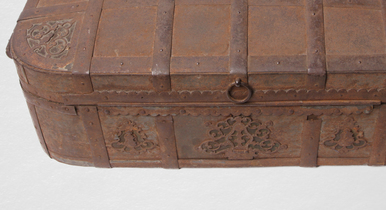The museum collection houses a samovar of the end of the 19th century with the volume of 12–15 liters. Such samovars became popular at the end of the 18th century: they were at the road stations, where it was possible to rest and tidy the horses. They usually used wood and wood chips to heat the samovars. But pine cones were considered the best fuel: they not only burned quickly, but gave a pleasant taste and aroma to the tea.
Samovars quickly came into fashion in Russia because of the harsh climate: they provided boiling water and helped to heat the house. Despite the high cost, even poor people bought them. The price for a samovar was often determined by its weight: the heavier the vessel, the more expensive it was.
Samovar is considered to be an original Russian symbol of hospitality and an integral part of life of the Slavic people. However, it was invented much earlier — several thousand years ago. And not in Russia, as is commonly believed, but in the Ancient East.
There is a legend, according to which the samovars, as they are known now, were brought to Russia from Holland by Peter the Great. But in reality they appeared half a century after the emperor’s death. For the first time they were made not in Tula, but in the Urals: 16 pound copper samovar is mentioned in the documents dated 1740. The first mention of Tula samovar was found only 6 years later.
Samovars were made in many different forms — in Tula alone there were more than 150 types. Ovoid samovars were popular as well as models similar to the ancient Greek vessels. Portable samovars with removable legs were also in demand — they were rectangular, polyhedral or cubic forms.
The samovar had many different regional names. For example, in Yaroslavl it was called “samogar”, in Kursk — “samokipts”, and in Vyatka — “samogrey”.
Samovars quickly came into fashion in Russia because of the harsh climate: they provided boiling water and helped to heat the house. Despite the high cost, even poor people bought them. The price for a samovar was often determined by its weight: the heavier the vessel, the more expensive it was.
Samovar is considered to be an original Russian symbol of hospitality and an integral part of life of the Slavic people. However, it was invented much earlier — several thousand years ago. And not in Russia, as is commonly believed, but in the Ancient East.
There is a legend, according to which the samovars, as they are known now, were brought to Russia from Holland by Peter the Great. But in reality they appeared half a century after the emperor’s death. For the first time they were made not in Tula, but in the Urals: 16 pound copper samovar is mentioned in the documents dated 1740. The first mention of Tula samovar was found only 6 years later.
The production of samovars was quite a labor-consuming process. At different times they were made of different metals: the very first items were copper or melchior; later, brass ones appeared. Usually, inside the samovar, there were two parts divided by partitions: in one of them, food was cooked, and in the second part, water for tea was boiled.
Samovars were made in many different forms — in Tula alone there were more than 150 types. Ovoid samovars were popular as well as models similar to the ancient Greek vessels. Portable samovars with removable legs were also in demand — they were rectangular, polyhedral or cubic forms.
The samovar had many different regional names. For example, in Yaroslavl it was called “samogar”, in Kursk — “samokipts”, and in Vyatka — “samogrey”.



